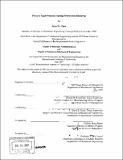| dc.contributor.advisor | Donald B. Rosenfield and David E. Hardt. | en_US |
| dc.contributor.author | Chew, Ryan W. (Ryan Wayne) | en_US |
| dc.contributor.other | Leaders for Manufacturing Program. | en_US |
| dc.date.accessioned | 2007-11-16T14:29:41Z | |
| dc.date.available | 2007-11-16T14:29:41Z | |
| dc.date.copyright | 2007 | en_US |
| dc.date.issued | 2007 | en_US |
| dc.identifier.uri | http://hdl.handle.net/1721.1/39589 | |
| dc.description | Thesis (M.B.A.)--Massachusetts Institute of Technology, Sloan School of Management; and, (S.M.)--Massachusetts Institute of Technology, Dept. of Mechanical Engineering; in conjunction with the Leaders for Manufacturing Program at MIT, 2007. | en_US |
| dc.description | Includes bibliographical references (p. 62-63). | en_US |
| dc.description.abstract | Raytheon Company is currently ramping up production radars for a fighter aircraft. This product is doubling production in the next year to meet customer demand; however, the program has not been able to meet the current demand schedule for the radar. In addition, the cost of producing this radar is over the budgeted amount. Management is pushing cost and cycle time reductions on every piece of the radar, a task the team is diligently working to accomplish. The main focus of this project is one sub-assembly of the AESA radar system, the "coldwall", a heat sink that also provides the base structure by which all of the radar sensing equipment is connect to. The coldwall also acts as a heat sink, reducing the internal temperature of the radar assembly, thereby improving the fidelity of the radio frequency signal and longevity of the system itself. Currently, the cycle time to manufacture the coldwall is on average twice the planned cycle time and the cost is three times the budgeted amount. This thesis provides a case in which a process improvement investigation takes place under tight budgetary and time constraints in ramp-up mode. | en_US |
| dc.description.abstract | (cont.) The goal of this thesis is to develop a case for accurate and complete data collection to help future process improvement decisions. The act of focusing this investigation was cumbersome due to the lack of data available on the process. In addition, the case study shows a situation where proactive issue resolution and active waste elimination could alleviate the stress incurred by cost over runs and delayed product shipments. | en_US |
| dc.description.statementofresponsibility | by Ryan W. Chew. | en_US |
| dc.format.extent | 63 p. | en_US |
| dc.language.iso | eng | en_US |
| dc.publisher | Massachusetts Institute of Technology | en_US |
| dc.rights | M.I.T. theses are protected by copyright. They may be viewed from this source for any purpose, but reproduction or distribution in any format is prohibited without written permission. See provided URL for inquiries about permission. | en_US |
| dc.rights.uri | http://dspace.mit.edu/handle/1721.1/7582 | |
| dc.subject | Sloan School of Management. | en_US |
| dc.subject | Mechanical Engineering. | en_US |
| dc.subject | Leaders for Manufacturing Program. | en_US |
| dc.title | Process improvements during production ramp-up | en_US |
| dc.type | Thesis | en_US |
| dc.description.degree | S.M. | en_US |
| dc.description.degree | M.B.A. | en_US |
| dc.contributor.department | Leaders for Manufacturing Program at MIT | en_US |
| dc.contributor.department | Massachusetts Institute of Technology. Department of Mechanical Engineering | |
| dc.contributor.department | Sloan School of Management | |
| dc.identifier.oclc | 175297991 | en_US |
